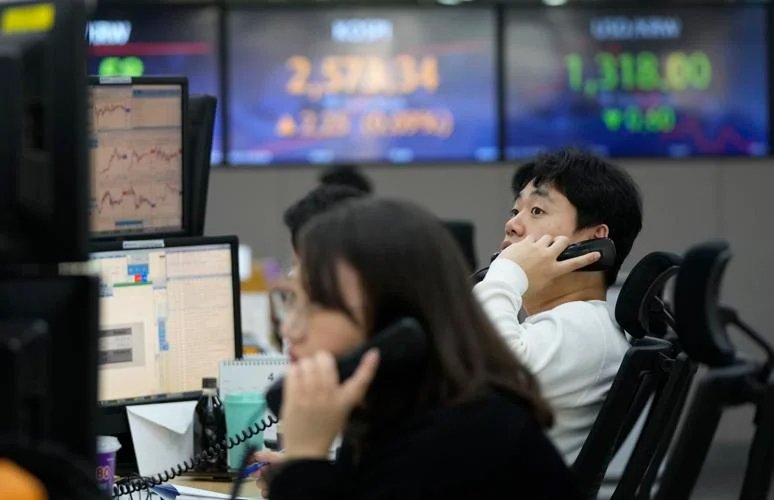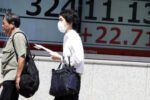TOKYO, April 19 (AP): Asian shares were mixed on Wednesday, as investors took a wait-and-see stance ahead of earnings reports and possible moves by central banks.
Japan’s benchmark Nikkei 225 slipped 0.2 per cent to finish at 28,606.76. Australia’s S and P/ASX 200 edged up nearly 0.1per cent to 7,365.50. South Korea’s Kospi gained less than 0.1 per cent to 2,573.58. Hong Kong’s Hang Seng lost 1.2 per cent to 20,410.16. The Shanghai Composite shed 0.6 per cent to 3,371.66.
News that China’s economic growth accelerated in the latest quarter, to an annual 4.5 per cent, did not have much of an impact on share prices.
While consumption and retail sales have grown, other indicators, such as industrial output and fixed-asset investments, were weaker and indicate an uneven recovery.
“It may still be a worst-is-over story, but recovery has shown to be more gradual than a one-shot wonder,” Yeap Jun Rong, market analyst at IG, said in a report.
Wall Street closed little changed after a day of meandering trading.
The S and P 500 edged up 0.1 per cent to 4,154.87 after drifting between small gains and losses throughout the day.
The Dow Jones Industrial Average slipped less than 0.1 per cent to 33,976.63 and the Nasdaq composite was down less than 0.1 per cent, at 12,153.41.
Lockheed Martin was one of Wall Street’s bigger gainers. It climbed 2.4 per cent after reporting a profit for the latest quarter that topped analysts’ expectations.
Bank of America rose 0.6 per cent after its better-than-expected profit report led to an up-and-down day of trading. The majority of companies have been beating forecasts so far in the early days of this reporting season.
The bar was low amid Wall Street’s worries about still-high inflation, much higher interest rates and slower growth in some sections of the economy.
Analysts came into this reporting season forecasting the sharpest drop in earnings per share for S and P 500 companies since the pandemic torpedoed the economy in 2020.
Several companies stumbled after failing to meet expectations. Goldman Sachs fell 1.7 per cent after its revenue fell short of analysts’ forecasts, though earnings topped expectations.
Health care stocks were broadly weak and the heaviest weight on the S and P 500 out of the 11 sectors that make up the index. Johnson and Johnson fell 2.8 per cent despite reporting stronger profit than expected and raising its dividend.
Coming up later this week will be reports from several dozen more companies in the S and P 500. They include big names such as AT and T, Tesla and Procter and Gamble.
Wall Street’s attention will also turn to reporting by smaller, regional banks such as KeyCorp and Zions Bancorp.
Their stocks took a hit last month following the second- and third-largest US bank failures in history.
The worry was that customers could pull their deposits out of banks together at once, similar to the runs that toppled Silicon Valley Bank and Signature Bank.
Most of the focus has been on regional banks instead of the massive “too-big-to-fail” banks like JPMorgan Chase and Bank of America.
Those big banks have so far been reporting better profits than expected, and their immense size may have helped lure deposits amid the turmoil. Their strength has helped add some calm to markets.
A larger worry for the economy is that the banking industry’s woes could cause a pullback in lending, pressuring an economy already straining under the weight of much higher interest rates.
The Federal Reserve has jacked rates up at a furious pace over the last year in hopes of slowing high inflation. High rates can suffocate inflation, but only by slowing the entire economy in one blunt action, raising the risk of a recession and hurting investment prices.
Inflation is slowing, but it’s still high, and traders widely expect the Fed to raise rates again at its next meeting in May.
In energy trading, benchmark US crude fell 47 cents to USD 80.39 a barrel in electronic trading on the New York Mercantile Exchange. Brent crude, the international standard, declined 44 cents to USD 84.33 a barrel.
In currency trading, the US dollar rose to 134.73 Japanese yen from 134.12 yen. The euro fell to USD 1.0951 from USD 1.0975.












